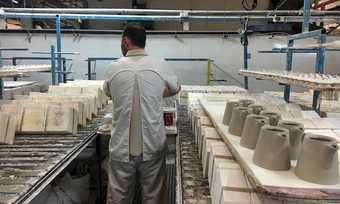
Clare Twomey Dudson Factory, Stoke-on-Trent 2017 © Clare Twomey Studio
Clare Twomey's FACTORY: the seen and the unseen launches Tate Exchange 2017/18
A ceramics factory where the public can mould or cast jugs, teapots and flowers opens at Tate Modern today, 28 September 2017. Artist Clare Twomey’s installation, FACTORY: the seen and the unseen, launches the second year of Tate Exchange which, over 2017 and 2018, will focus on the theme of production.
The installation occupies the whole of Tate Exchange in Freelands Foundation Studios on Level 5 of Tate Modern’s Blavatnik Building and comprises a 30-metre work space, eight tonnes of clay, a vast area of drying racks, and over 2,000 fired clay objects. Over a six-month period, Clare Twomey has worked closely with Dudson of Stoke-on-Trent to develop this industrial production line. For the next four days, visitors will be invited to clock in and learn the skills of working with clay. They will then exchange what they have made for other objects made in a factory setting. During the second week of the project, the production line will stop and the visitor will be invited to enter a factory soundscape and join a factory tour to discuss how communities are built by collective labour. A lace panel devised by Clare Twomey on the last working Leavers looms in the UK, has been installed at the FACTORY entrance, embodying the relationship between human and machine innovation. Visitors can find out more about the panel and the ceramics factory by downloading a free app on site which uses newly-developed technology specially devised for use in decorative imagery, patterns and drawing.
Tate Exchange invites the public to test ideas and explore new perspectives, illuminating the value of art to society. In Tate Exchange: Production, from September 2017 to January 2018, artists’ projects will examine the role of the museum in production, exploring this theme through a variety of different viewpoints. From January to May 2018, 60 Associate organisations at Tate Modern and 24 at Tate Liverpool will work with the public in the galleries, continuing the theme. A full list of Associates taking part is supplied below.
The artists’ projects at Tate Modern will include, among others: TENT of Rotterdam with Tate Collectives looking at ‘high’ and ‘low’ culture and where it is produced; and BBZ who will explore the cultural production of non-binary black artists and collectives in the UK. At Tate Liverpool, artist-led gallery The Royal Standard will examine the theme from the perspective of feminist and activist communities; and Cooking Sections will devise new systems for producing and consuming food.
Tate Exchange’s annual themes are closely aligned to Tate’s exhibitions and collection displays from which contributors to the project can draw. SUPERFLEX, the artists undertaking this year’s Hyundai commission, will participate in Tate Exchange, playfully exploring how artwork can be used, modified and distributed. At Tate Liverpool, Illustrating Futures, a collaboration between the University of Liverpool and Comics Youth, will focus on the relationship between the production of comics and mental health in response to the ARTIST ROOMS: Roy Lichtenstein in Focus exhibition.
In its inaugural year, over 230,000 people took part in Tate Exchange activities across Tate Modern and Tate Liverpool.
Anna Cutler, Director of Tate Learning said:
We were overwhelmed by the generous public response to Tate Exchange in its first year. It became a civic space in which the public got to share their ideas, thoughts and opinions. We are indebted to the work of the Associates who generated extraordinary programmes and took on the task of an open experiment with great skill and verve. In our second year, we will look at the theme of production and dig even deeper into debate and the nature of exchange.
The FACTORY is open for two blocks of four days – 28 September to 1 October and 5 to 8 October - from 12.00 until 18.00. On Friday 29 September, FACTORY will remain open until 22.00 as part of the Uniqlo Tate Late.
Tate Exchange: Production is supported by Maryam and Edward Eisler, Red Hat Inc., Paul Hamlyn Foundation and Art Fund.
With founding support from Freelands Foundation.
FACTORY: the seen and the unseen has received additional support from Dudson, the University of Westminster, the University of Nottingham and the British Ceramic Biennial.
